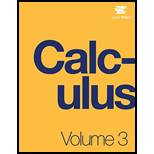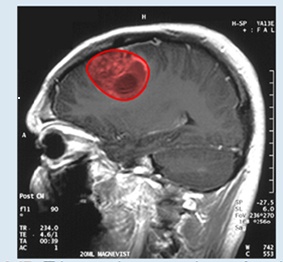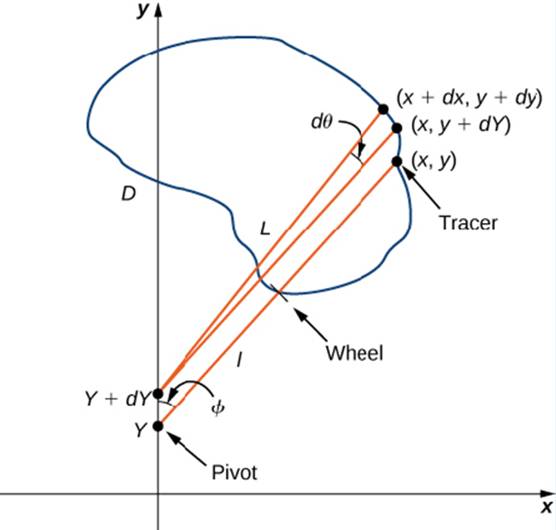
Concept explainers
Measuring Area from a Boundary: The Planimeter

Figure 6.47 This magnetic resonance image of a patient’s brain shows a tumor, which is highlighted in red. (credit: modification of wood’ by Christaras A Wikimedia Commons)
Imagine you are a doctor who has just received a magnetic resonance image of your patent’s brain. The brain has a tumor (Figure 6.47). How large is the tumor? To be precise, what is the area of the red region? The red cross-section of the tumor has an irregular shape, and therefore it is unlikely that you would be able o find a set of equations or inequalities for the region and then be able to calculate its area by conventional means. You could approximate the area by chopping the region into tiny squares (a Riemann sum approach), but this method always gives an answer with some error.
Instead of trying to measure the area of the region directly, we can use a device called a rolling planimeter to calculate the area of the region exactly, simply by measuring its boundary. In this project you investigate how a planimeter works, and you use Green’s theorem to show the device calculates area correctly.
A rolling planimeter is a device that measures the area of a planar region by tracing out the boundary of that region (Figure 6.48). To measure the area of a region, we simply run the tracer of the planimeter around the boundary of the region. The planimeter measures the number of turns through which the wheel rotates as we (race the boundary; the area of the shape is proportional to this number of wheel ruins. We can derive the precise proportionality equation using Green’s theorem. As the (racer moves around the boundary of the region, the tracer arm rotates and the roller moves back and forth (but does no; rotate).

Figure 6.48 (a) A rolling planimeter. The pivot allows the tracer arm to rotate. The roller itself does not rotate; it only moves back and forth. (b) An interior view of a rolling planimeter. Notice that the wheel cannot rum if the planimeter is moving back and forth th the tracer arm perpendicular to the roller.
Let C denote the boundary of region D. the area to be calculated. As the tracer traverses curve C, assume the roller moves along the y-axis (since the roller does not rotate, one can assume it moves along a straight line). Use the coordinates (x, y) to represent points on boundary C, and coordinates (0, y) to represent the position of the pivot. As the planimeter traces C. the pivot moves along the y-axis while the tracer arm rotates on the pivot.  Watch a short animation (http://www.openstaxcollege.org/I/20_pianimeter) of a planimeter in action. Begin the analysis by considering the motion of the tracer as it moves from point (x, y) counterclockwise to point (x + dx. y + dy) that is close to (x, y) (Figure 6.49). The pivot also moves, from point (0, y) to nearby point (0, y + dy). How much does the wheel turn as a result of this motion? To answer this question, break the motion into two parts. First, roll the pivot along they-axis from (0. y) to (0, y + dy) without rotating the tracer arm. The tracer arm then ends up a point (x, y + dy) while maintaining a constant angle with the x-axis. Second, rotate the tracer arm by an angle d
Watch a short animation (http://www.openstaxcollege.org/I/20_pianimeter) of a planimeter in action. Begin the analysis by considering the motion of the tracer as it moves from point (x, y) counterclockwise to point (x + dx. y + dy) that is close to (x, y) (Figure 6.49). The pivot also moves, from point (0, y) to nearby point (0, y + dy). How much does the wheel turn as a result of this motion? To answer this question, break the motion into two parts. First, roll the pivot along they-axis from (0. y) to (0, y + dy) without rotating the tracer arm. The tracer arm then ends up a point (x, y + dy) while maintaining a constant angle with the x-axis. Second, rotate the tracer arm by an angle d

Figure 6.49 Mathematical analysis of the motion of the planimeter.
7. Use Green’s theorem to show that
Want to see the full answer?
Check out a sample textbook solution
Chapter 6 Solutions
Calculus Volume 3
Additional Math Textbook Solutions
Calculus Volume 1
Introductory Statistics
Probability and Statistics for Engineers and Scientists
Using and Understanding Mathematics: A Quantitative Reasoning Approach (6th Edition)
Finite Mathematics for Business, Economics, Life Sciences and Social Sciences
- PART 1: DETERMINE THE CENTROID IN X (? ") and THE MOMENT INERTIA IN (Iy) OF THE FOLLOWING FIGUREarrow_forwardQuestion Number 4: Sketch the curve and find the total area between the curve and the given interval on X-axis.i) y=sinx; [0,3pi/2]ii) y=x2-1/x2 ; [1/2,2]arrow_forwardA solid non-conducting sphere of radius 3 cm has a charge of +24 micro(u)C. A conducting spherical shell of inner radius 6 cm and outer radius 10 cm is concentric with the solid non-conducting sphere and carries a charge of -10 micro C. What is the electric field at r=1cmarrow_forward
- find the moment of inertia with respect to the origin: 1. the area of the curve r^2 =a^2 cos 2 θarrow_forwardThe area A of a triangle with sides of lengths a and benclosing an angle of measure u isA = 1/2 ab sin θ. How is dA/dt related to dθ/dt and da/dt if only b is constant?arrow_forwardThe area described in question 1(b) is filled by a flat metal plate with a surfacedensity σ = 3x. If the plate is secured to the y-axis by massless hinges,calculate its moment of inertia about the y-axis.[Note: the moment of inertia of a point mass, m is I = md^2, where d is thedistance to the rotation axis under consideration].arrow_forward
- Algebra & Trigonometry with Analytic GeometryAlgebraISBN:9781133382119Author:SwokowskiPublisher:Cengage
